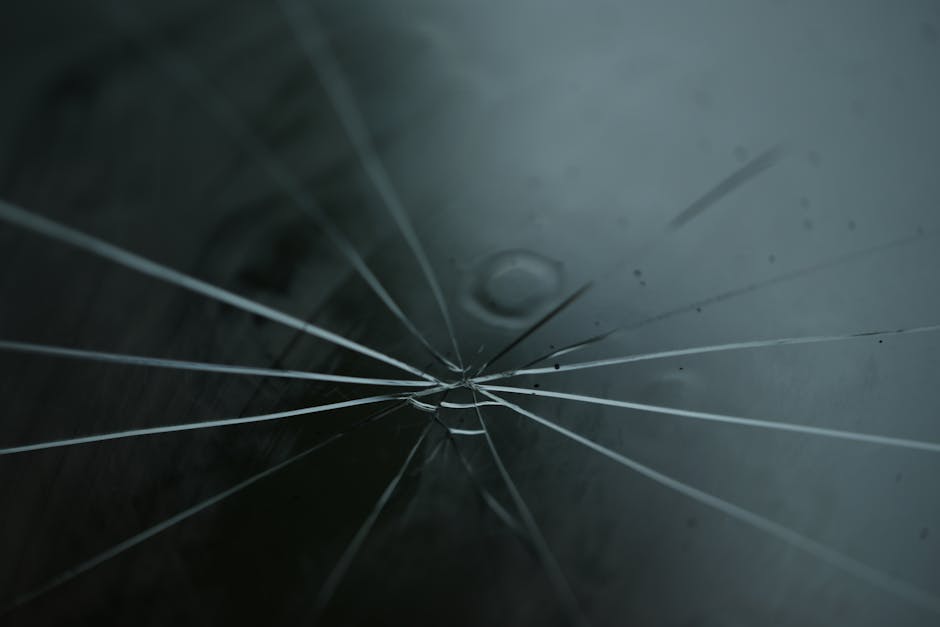The Hidden Dangers: Windshield Cracks Inside the Glass
A “windshield crack inside glass” might seem like a small issue, but it can actually be a big safety concern.
When it comes to internal windshield cracks, they can often appear without warning and are primarily caused by stress fractures. These fractures usually result from sudden changes in temperature or pressure inside your vehicle.
Key Reasons for Internal Windshield Cracks:
– Sudden Temperature Changes: Extreme shifts, like blasting the AC on a hot day or using hot water to defrost in winter.
– Pressure Variations: Rapid changes in pressure can stress the glass from the inside.
– Vibrations: Frequent driving on rough roads or over potholes can contribute to internal windshield stress.
Addressing and resolving these cracks promptly is crucial for maintaining your vehicle’s safety. A compromised windshield can obstruct your vision and affect the structural integrity of your car during collisions.
My name is Rich Main, and I’ve been in the glass business for most of my life, owning Vista Glass with my wife since 2000. My extensive experience over the years has given me deep knowledge about stress fractures and safety concerns related to a “windshield crack inside glass.”

Let’s dive deeper into understanding the causes and solutions for inside windshield cracks.
Windshield crack inside glass word list:
– crack on windshield getting bigger
– state farm broken windshield
– windshield broken by stone
Causes of Inside Windshield Cracks
When a windshield crack inside glass appears, it can be puzzling and concerning. Understanding the causes can help prevent them. Here are some common reasons:
Temperature Changes
Extreme temperature changes are a leading cause of internal windshield cracks. When your car is exposed to direct sunlight and then suddenly cooled by air conditioning, the rapid expansion and contraction can stress the glass.
- Hot Car, Cold Air: Blasting the AC on a hot day can cause the glass to contract quickly.
- Cold Car, Hot Defroster: Using hot air to defrost a cold windshield can have the opposite effect, causing the glass to expand rapidly.
These rapid changes create stress fractures over time, leading to internal cracks.
Manufacturing Defects and Poor Installation
Sometimes, the issue starts at the factory. Manufacturing defects can make windshields more prone to cracking.
- Structural Weakness: Small imperfections or uneven stress distribution during manufacturing can weaken the glass.
- Edges of the Windscreen: Poor installation can leave the edges of the windshield vulnerable to stress cracks.
Using a professional technician and high-quality materials during installation can minimize these risks.
Wear and Tear
Older vehicles are more susceptible to internal windshield cracks due to wear and tear.
- Old Sealants: Over time, sealants can degrade, leading to leaks and weakened glass.
- Body Flexing: The car’s body can flex during driving, especially on rough roads, causing stress on the windshield.
- Internal Structures: Aging internal structures can also contribute to the problem.
Regular maintenance and inspections can help identify and address these issues before they cause cracks.
Loud Noises
Believe it or not, loud music can contribute to windshield cracks. Sound vibrations from blasting music inside the car can stress the glass, especially if there is pre-existing damage.
- Pre-Existing Damage: If your windshield already has minor chips or cracks, loud music can exacerbate the problem.
Lowering the volume can help reduce the risk of stress fractures.
By understanding these causes, you can take steps to prevent a windshield crack inside glass and ensure your safety on the road.
How to Repair Inside Windshield Cracks
When dealing with a windshield crack inside glass, you have two main options: DIY repair methods or professional repair and replacement. Each method has its pros and cons, and the right choice depends on the severity and location of the crack.
DIY Repair Methods
For minor cracks and chips, a windshield repair kit can be a convenient solution. Here’s a step-by-step guide to using one:
- Clean the Glass: Start by cleaning the area around the crack. Use a microfiber towel and a small amount of rubbing alcohol to remove any dirt or debris. Make sure the area is completely dry before proceeding.
- Apply the Adhesive Patch: Most repair kits include an adhesive patch. Remove the paper backing and place the patch over the damaged area on the exterior of the windshield. Ensure it’s centered and firmly attached.
- Inject the Epoxy Resin: Fill the included pedestal with epoxy resin and use the syringe to compress it into the crack. The resin should flow into the crack, filling it completely.
- Curing Process: Allow the resin to cure as per the kit instructions. This often involves leaving the car in direct sunlight or using a UV light to harden the resin. The curing process is crucial to ensure the resin bonds properly with the glass.
- Remove Excess Resin: Once cured, remove any excess resin from the surface. Your windshield should now be more structurally sound.
Professional Repair and Replacement
For more severe cracks or if you’re unsure about doing it yourself, seeking a qualified technician is the best option. Here’s why:
- High-Quality Products: Professionals use top-tier materials that are more effective than DIY kits.
- Structural Integrity: A professional repair ensures that the windshield’s structural integrity is maintained, which is crucial for your safety.
- Safety: Technicians follow strict safety protocols to ensure the repair is done correctly.
When to Consider Replacement
In some cases, a crack may be too severe to repair. According to industry guidelines, cracks that are too deep, long, or located in critical vision areas often require a complete windshield replacement. Here are scenarios where replacement is necessary:
- Multiple Cracks: If there are several cracks or chips, replacing the windshield is safer.
- Driver’s Vision Area: Cracks in the driver’s line of sight can impair vision and are best addressed with a replacement.
- Polluted Cracks: If the crack is stained or has been exposed to contaminants, it may not bond well with repair materials.
At Vista Glass, our technicians are trained to assess the damage and recommend the best course of action. We prioritize your safety and use only high-quality products to ensure a durable and reliable repair or replacement.
By understanding these repair methods, you can make an informed decision and ensure your windshield remains in top condition.
Preventing Inside Windshield Cracks
Use a Windshield Cover
A windshield cover is a simple yet effective tool to prevent stress cracks. It helps control the temperature inside your car, protecting the glass from extreme heat or cold. Many people think they only need a cover in the summer, but it’s useful year-round. Even on a cool day, the temperature inside a parked car can be over 20°C hotter than outside. So, always use your cover to keep your windshield safe.
Invest in Window Tinting
Window tinting can be a great investment to protect your windshield. Tinted windows reduce heat by blocking 35% to 65% of the sun’s rays, depending on the quality of the tint. This not only prevents your car from overheating but also reduces the stress on your windshield. Additionally, less heat means you won’t need to use the air conditioning as much, which can save on fuel.
Change Your Habits
When you get into a hot car, it’s tempting to blast the air conditioning. However, this sudden temperature change can cause your windshield to crack. Instead, allow the car to cool down gradually. Roll down the windows to let the hot air escape before turning on the air conditioning. If your car is parked in a secure location, leaving a small crack in the window can help promote air circulation and prevent rapid temperature changes.
Lower Your Music
Playing loud music can create sound vibrations that may cause or worsen stress cracks, especially if your windshield is already damaged. Keep your music at a reasonable level to avoid these vibrations. Lower music not only protects your windshield but also helps prevent hearing damage and distractions while driving.
Regular Maintenance
Inspecting your windshield regularly can help you catch small cracks before they become big problems. Also, check the sealants around your windshield. Over time, these can wear out and contribute to stress cracks. If you notice any damage, seek professional services promptly to prevent imminent damage.
By following these simple tips, you can extend the life of your windshield and avoid costly repairs.
Frequently Asked Questions about Inside Windshield Cracks
Can a crack on the inside of a windshield be repaired?
Repairing a windshield crack inside glass can be tricky. The difficulty lies in the structural impact and safety concerns. According to the National Windshield Repair Association (NWRA), cracks on the inner layer of the windshield should not be repaired. This is because the structural integrity of the glass is already compromised, making it unsafe.
Safety Tip: If you have an inside crack, it’s best to consult a professional to assess the damage and recommend the safest solution.
Can an internal windscreen crack be repaired?
Internal windscreen cracks are subject to oxidation damage and heat absorption. Over time, these factors can weaken the glass further.

Oxidation Damage: When a crack is exposed to air, it can oxidize, making repairs more difficult and less effective.
Heat Absorption: Cracks can also absorb heat, which can worsen the damage. This makes replacement a more reliable option compared to repair.
How to fix a crack in between windshield glass?
If you decide to repair a crack yourself, a windshield repair kit can be handy. Here’s a simple guide:
- Clean the Glass: Ensure the area around the crack is clean.
- Apply the Adhesive Patch: Follow the instructions to place the adhesive patch over the crack.
- Inject Epoxy Resin: Use the kit to inject epoxy resin into the crack. This resin will fill the crack and bond the glass.
- Curing Process: Allow the resin to cure as per the instructions. This usually involves leaving the car in sunlight or using a UV light.

Note: DIY repairs are not always effective for large or complex cracks. If the crack is extensive, consult a professional to ensure the safety and structural integrity of your windshield.
By understanding these factors, you can make informed decisions about repairing or replacing your windshield.
Conclusion
At Vista Glass, we understand that dealing with a windshield crack inside glass can be stressful. Our priority is your safety and satisfaction. With over 25 years of experience, we offer expert auto glass repair and replacement services custom to meet your needs.
Mobile Service: One of our unique offerings is our mobile service. We come to you, whether you’re at home, work, or anywhere in Tucson. This means you don’t have to risk driving with a compromised windshield.
Customer Satisfaction: Our commitment to customer satisfaction is unwavering. We ensure that every job is done right the first time. Our technicians are highly trained and use only top-quality materials to guarantee the best results.
Prompt Repair: Time is of the essence when it comes to windshield cracks. The longer you wait, the more likely the crack will worsen, compromising your safety. We offer quick and efficient services to fix your windshield promptly.
Safety Priority: Your safety is our top concern. A cracked windshield can be a serious hazard, and we take every precaution to ensure that your vehicle’s structural integrity is maintained. Whether it’s a minor repair or a full replacement, we make sure your windshield is safe and secure.
For more information or to schedule an appointment, visit our Windshield Repair Service page.
Don’t wait—contact us today to ensure your windshield is in top condition. Your safety and satisfaction are our top priorities.

